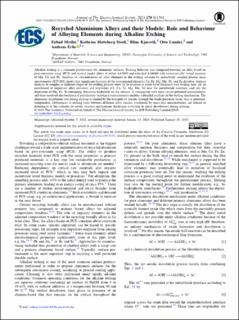| dc.contributor.author | Mysliu, Erlind | |
| dc.contributor.author | Sletteberg Storli, Kathrine | |
| dc.contributor.author | Kjørsvik, Eline | |
| dc.contributor.author | Lunder, Otto | |
| dc.contributor.author | Erbe, Andreas | |
| dc.date.accessioned | 2023-04-21T12:14:01Z | |
| dc.date.available | 2023-04-21T12:14:01Z | |
| dc.date.created | 2023-02-18T19:35:14Z | |
| dc.date.issued | 2023 | |
| dc.identifier.citation | Journal of the Electrochemical Society. 2023, 170 (1), 011503. | en_US |
| dc.identifier.issn | 0013-4651 | |
| dc.identifier.uri | https://hdl.handle.net/11250/3064273 | |
| dc.description.abstract | Alkaline etching is a common pretreatment for aluminum surfaces. Etching behavior was compared between an alloy based on post-consumer scrap (PCS) and several model alloys of rolled AA3005 and extruded AA6060 with systematically varied amounts of Mn, Cu and Ni. Analysis of concentrations of alloy elements in the etching solution by inductively coupled plasma mass spectrometry (ICP-MS) shows that significant fractions of the investigated elements Cu, Fe, Mg, Mn, Ni, and Zn dissolve. Surface analysis of samples in different stages of the etching process show (i) an increase in oxide layer thickness with etching time, (ii) an enrichment of important alloy elements and impurities (Cr, Cu, Fe, Mg, Mn, Si) near the metal/oxide interface, and (iii) the deposition of Mg, Fe, Si-containing aluminum hydroxide on the surface. A comparison with open circuit potential measurements and time-resolved electrochemical polarization resistance measurements enables a detailed analysis of the etching mechanism. The aluminum dissolution rate during etching is limited by the transport of species through the oxide precursor layer, thus is potential-independent. Differences in etching rates between different alloy classes, evidenced by mass loss measurements, are related to differences in the cathodic or anodic reaction mechanisms (hydrogen evolution or metal dissolution) during etching. | en_US |
| dc.language.iso | eng | en_US |
| dc.publisher | IOP Press | en_US |
| dc.rights | Navngivelse 4.0 Internasjonal | * |
| dc.rights.uri | http://creativecommons.org/licenses/by/4.0/deed.no | * |
| dc.title | Recycled Aluminium Alloys and their Models: Role and Behaviour of Alloying Elements during Alkaline Etching | en_US |
| dc.title.alternative | Recycled Aluminium Alloys and their Models: Role and Behaviour of Alloying Elements during Alkaline Etching | en_US |
| dc.type | Peer reviewed | en_US |
| dc.type | Journal article | en_US |
| dc.description.version | publishedVersion | en_US |
| dc.rights.holder | © 2023 The Author(s) | en_US |
| dc.source.volume | 170 | en_US |
| dc.source.journal | Journal of the Electrochemical Society | en_US |
| dc.source.issue | 1 | en_US |
| dc.identifier.doi | 10.1149/1945-7111/acb38a | |
| dc.identifier.cristin | 2127250 | |
| dc.relation.project | Norges forskningsråd: 309875 | en_US |
| dc.source.articlenumber | 011503 | en_US |
| cristin.ispublished | true | |
| cristin.fulltext | original | |
| cristin.qualitycode | 2 | |

